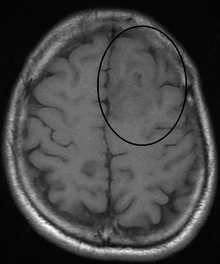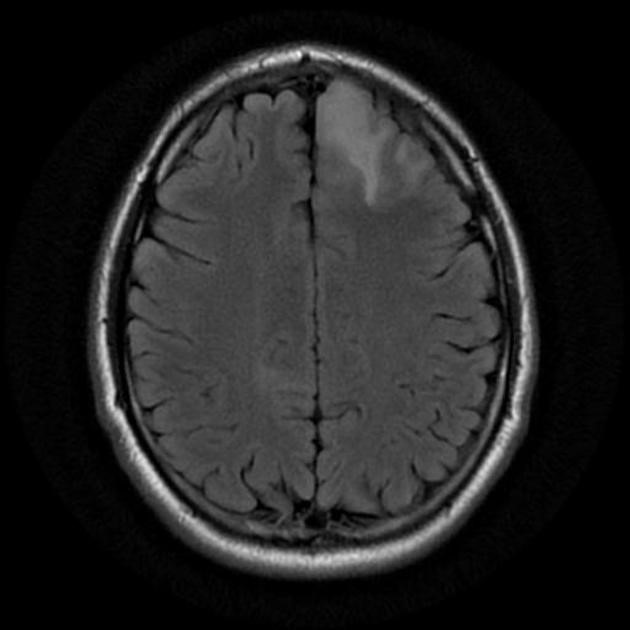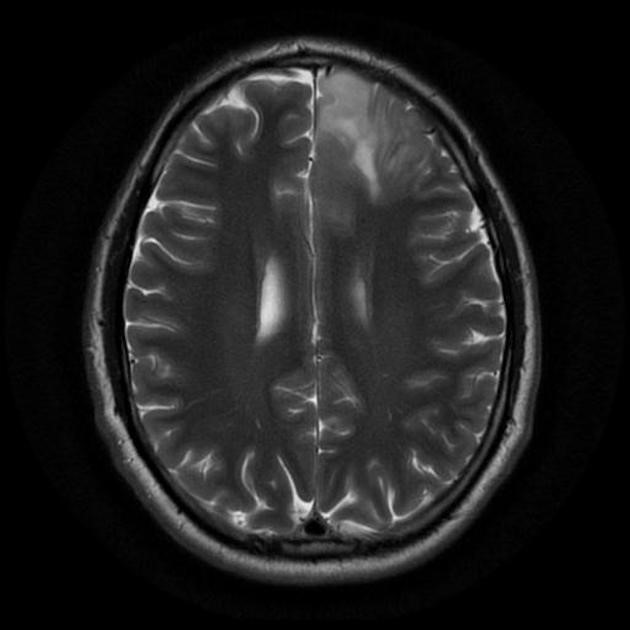Woman Credits Cannabis Oil With Treating Her Brain Cancer
This is the remarkable story of the beautiful Kelly Hauf, and how she dissolved her brain tumor using cannabis oil when nothing else helped. Kelly suffers from a type of tumor that medically speaking is incurable. Even when surgically removed under the best surgical and technical expertise, they often return to curse the patient. Relentless is the operative (pun intended) word here. Modern modalities such as chemotherapy and radiation only tend to slow growth. They are not curative and surgery often presents with more aggressive relapses.
Therefore, eventually the tumor will catch up to you in the end. That’s why this case is so important to us. We see marijuana oil doing what chemo and radiation aren’t able to do. The oil apparently has not only arrested the tumor’s growth but it has caused the tumor to disappear. This included an unresectable portion that vanished and was replaced by normal cell parenchyma.
The whole narrative started when Kelly was just 38 years old when she suddenly developed a severe headache that would not go away. She saw her doctor who ordered a CT scan. What the CT scan showed would change her life forever. They discovered a 3 centimeter mass in the left frontal lobe of her brain. The following quotations from Kelly come from the website, www.cureyourowncancer.org.
Kelly:
Immediate brain surgery was recommended by my surgeon. However, after further discussion, due to slow growth and no adjacent edema, he felt it would not be negligent to postpone surgery and monitor the tumor every 3 months with an MRI. The tumor remained stable for a little over three years then suddenly grew 25 percent.
On September 4, 2003, when I was 41, on my husband’s 42nd birthday, I had surgery at Cedars Sinai in Los Angeles. I spent the next day, our 19th wedding anniversary in ICU. The pathology report came back an Oligodendroglioma grade 2. The surgery was an apparent success and neither radiation nor chemotherapy were recommended. However, since it’s unlikely every cancer cell can be detected and removed, and the nature of gliomas are to grow back over time, it was necessary to continue MRI monitoring every 3 months. Living from MRI to MRI had become our “normal.”
PATHOLOGY REPORT: OLIGODENDROGLIOMA GRADE 2
From Cancer Research UK:
Oligodendrogliomas are a type of glioma that are believed to originate from the oligodendrocytes of the brain or from a glial precursor cell. They occur primarily in adults (9.4% of all primary brain and central nervous system tumors) but are also found in children (4% of all primary brain tumors). The average age at diagnosis is 35 years.
Treatment for oligodendroglioma
Oligodendrogliomas are a type of glioma brain tumour. The treatment depends on whether it is a slowly growing type (low grade or grade 2) or a faster growing type (grade 3 or anaplastic tumour).
[From Wikipedia.org]. Because of the indolent nature of these tumors and the potential morbidity associated with neurosurgery, chemotherapy and radiation therapy, most neurooncologists will initially pursue a course of watchful waiting and treat patients symptomatically. Symptomatic treatment often includes the use of anticonvulsants for seizures and steroids for brain swelling. PCV chemotherapy (Procarbazine, CCNU and Vincristine) has been shown to be effective and was the most commonly used chemotherapy regimen used for treating anaplastic oligodendrogliomas, but is now being superseded by a newer drug: Temozolomide. Temozolomide is a common chemotherapeutic drug to which oligodendrogliomas appear to be quite sensitive. It is often used as a first line therapy, especially because of its relatively mild side effects when compared to other chemotherapeutic drugs. [emphasis mine]
Low grade oligodendroglioma
Some low grade oligodendrogliomas grow very slowly and your treatment team may suggest that you have regular monitoring with MRI scan or CT scan at first. Some tumours do not change for many months or years.
If the tumour is causing symptoms, is large, or has signs on the scans that it could be high grade, your doctors will recommend a biopsy or surgery to remove the tumour. Oligodendrogliomas tend to grow into the brain tissue surrounding the main tumour and this makes them difficult to remove completely. Often, some tumour is left behind after surgery. If the tumour is a very slowly growing type your doctor may recommend that you don’t have further treatment straight after the surgery but wait to see if the tumour causes symptoms. If the tumour is large or causes symptoms your treatment team will recommend radiotherapy or chemotherapy.[ref](http://www.cancerresearchuk.org/about-cancer/type/brain-tumour/treatment/types/treatment-for-oligodendroglioma#more) 12/14/2015[/ref]
Prognosis and treatment[ref](https://en.wikipedia.org/wiki/Oligodendroglioma) 12/14/2015[/ref]
Oligodendrogliomas are generally felt to be incurable using current treatments. However, compared to the more common astrocytomas, they are slowly growing with prolonged survival. In one series, median survival times for oligodendrogliomas were 11.6 years for grade II and 3.5 years for grade III.
Oligodendrogliomas, like all other infiltrating gliomas, have a very high (almost uniform) rate of recurrence and gradually increase in grade over time. Recurrent tumors are generally treated with more aggressive chemotherapy and radiation therapy. Recently, stereotactic surgery has proven successful in treating small tumors that have been diagnosed early.
Long-term survival is reported in a minority of patients. With aggressive treatment and close monitoring, it is possible to outlive the typical life expectancies for both low grade and high grade oligodendrogliomas. Westergaard’s study (1997) showed that patients younger than 20 years had a median survival of 17.5 years. Another study shows a 34% survival rate after 20 years. However, as discussed above, such figures can be misleading since they do not factor in the types of treatment nor the genetic signature of the tumors. As well, such historic data loses significance due to the relatively long survival of patients (compared to other types of brain tumors) and the introduction of newer treatment options over time.
A left frontal lobe oligodendroglioma as seen on MRI
From the literature above one can plainly see that this type of brain tumor, like most tumors in the central nervous system, is bad, certainly not as bad as glioblastoma but it still carries a very low long-term survival.
I’M BACK
November 2013. Prior to this date Kelly had been stable. Her tumor had not changed for 10 years until now. The most recent MRI showed that the tumor had started to grow again. (See MRI images above and below for a similar case involving a frontal lobe tumor in a male.). Notice the long tendrils the tumor displays (below) making them difficult to surgically remove.
At this time her surgeon in LA recommended six months of chemotherapy and reassess the tumor with another MRI. If the tumor was still growing, then surgery would be recommended to remove any remaining tumor.
Axial FLAIR image of brain. Note the tumor between 12 and 1 o’clock as the lighter grey area in the frontal cortex.
The above image is an Axial T2 weighted image which helps to identify the tumor region. The area of tumor is the lighter grey region between 12 and 1 o’clock. Notice how technically difficult it might be in removing tumors with this morphology. They often have long spindly “arms” of tumor that make surgical removal very challenging. This is where you would want an amazing surgeon helping out.
She was sent home with anti-seizure medication for a new condition that she developed from the tumor involvement. As the tumor continued to grow it had invaded into the brain’s region that processes olfactory information (scents and smells). Because of this neoplastic invasion, the tumor had destabilized the adjacent regions. She was having these strange sensations of smelling unusual odors. Kelly was having classic auras from olfactory seizure activity.
Kelly:
While researching Charlotte’s Web cannabis oil as an alternative to the prescribed seizure medicine I also found out that cannabis oil was also showing promise as a cancer treatment and could be an alternative to chemotherapy. I was living in a state that did not have legal access to cannabis but my youngest daughter, Jillian, was living in San Francisco where medical marijuana was legal.
When Jillian came home for Christmas she and my husband, Rick, decided it was time for me to make a decision to do something. I wasn’t ready to decide anything just yet. I wanted to have Christmas with my family. The day after Christmas I made up my mind to drive out to California to investigate cannabis oil as a treatment.
So Kelly and her husband moved to San Francisco and made the decision to take the 90-day cure made famous by Rick Simpson in his movie Run From the Cure.
After establishing residency in San Francisco, I was able to get a medical marijuana card. The card was for cancer treatment but, amazingly, the cannabis oil has helped me with my fibromyalgia pain, joint pain, and chronic headaches. I had this pain for many years and it was getting worse. I literally have no pain now. My blood pressure had been creeping up over the years and was consistently pre-hypertensive, now it’s consistently on the low side of normal. I have not taken any other medication except the cannabis oil, supplements, and good clean healthy food over the last 8 months. [Emphasis mine]
Kelly did the Full Monty, she went organic and started juicing fruits and vegetables, gluten free, non-GMO, fresh air and exercise. She had an MRI scheduled at the ninety-day cutoff point. However, she was not up to ingesting one gram of RSO per day, far from it.
Her repeat MRI showed no change in the main frontal lobe tumor. However, a smaller inoperable satellite tumor located in the cingulate gyrus, that had been plaguing her for ten years, had simply disappeared!
We were amazed and it gave us the encouragement we needed to continue the cannabis protocol. To get to the amount of a gram of oil a day took months of building up my tolerance. I had very physical challenges and setbacks during this process such as seizures, middle of the night walks, tremors, convulsions, nausea, frustration, lack of appetite, and many tears. I finally reached a gram a day and eventually up to two grams a day on the final two weeks before my second MRI at the end of August. [Emphasis mine]
In August, eight months after starting RSO, the tumor disappeared.
…my MRI was reviewed by a leading Radiologist, my Neuro Oncologist, and my world renowned Brain Surgeon, and it was concluded that all that was remaining of the tumor regrowth was scar tissue. I will have another MRI in December. Because these tumors are chronic and tend to grow back, I will always be living MRI to MRI, but the key word here is that I am living …and in great health with a great immune system. I was not left with my immune system compromised by chemo and radiation, which is the standard protocol for these types of tumors as well as other cancers. [Emphasis mine]
Later in the discussion, Kelly brought up an important point. That many states push for legalizing CBD at the expense of THC preparations. This is not good medical practice. Since we know so little about cannabis oil and treating cancers we are doing a disservice to patients by pretending that CBD is better than or equivalent to whole cannabis preparations. It is not.
It’s like allowing one class of antibiotics but disallowing other entire categories of antibiotics. Not good. Be sure to push for cannabis, not just CBD, legalization.
Let’s not be too quick to discount the other things that Kelly did such as changing her lifestyle habits, adding in all sorts of supplements, food as medicine, plus other healing modalities such as nurturing a sense of gratitude, positive emotions, prayer and meditation, yoga/exercise and mindful walking three miles a day. I’ll finish with a wonderful quote from Kelly.
The evidence is rapidly stacking up on the healing properties of the Marijuana plant. I’m excited for the future of Medical Marijuana and I feel a strong responsibility to spread this information. I hear so many misconceptions about this amazing medicinal plant that I feel a need to tell my story to anyone who is interested and my prayer is that it will be received with an open mind and a compassionate heart. Many Blessings to All




Be sure to push for cannabis, not just CBD, legalization. http://www.cancercureoil.com
How can I get some of this Oil??? I have an incurable form of bone marrow or blood cancer called Multiple Myeloma. Thanks
Check out “Run from the cure” on Youtube Marlene. Check facebook for a cannabis club in your area, or dispensary if you’re lucky enough to live where it’s legal. Best of luck to you!!
Hey Marlene, I get mine from http://www.rooandco.co.uk – they are very helpful so give them a call if you can
Thank you for sharing your story Kelly! I have the same tumour and grade 3 oligodendroglioma! Ive been doing the oil since I had my surgery, and my tumour grew 2mm into the center of my brain! So now that it’s Christmas, I’m going to enjoy my family and friends and fooooooood!! 🙂 I’m so glad your story has been made public! Thank you!
Hi Mandi,
Can you clarify something for me? Did your tumor grow 2mm AFTER surgery while taking RSO? Or are you tumor free now that you are on RSO?
Thanks
Chris